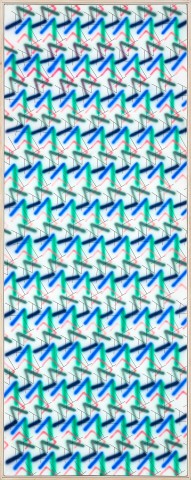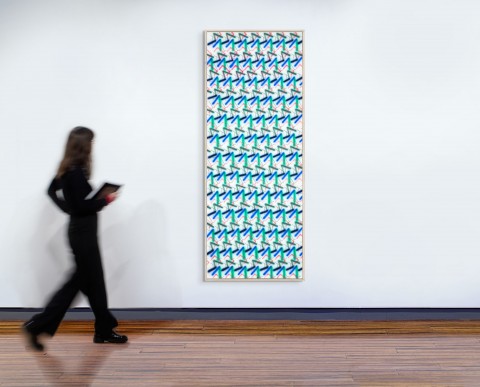Arrows and crosses, 1980
Howard Arkley
synthetic polymer paint on canvas
203.5 x 77.5 cm
signed, dated and inscribed with title verso: Arrows and Crosses. / H. Arkley 80
Coventry Gallery, Sydney
Private collection
Deutscher~Menzies, Melbourne, 10 August 1998, lot 169
Gould Galleries, Melbourne
Deutscher and Hackett, Melbourne, 16 April 2008, lot 55 (dated 1979)
Private collection, Brisbane
Howard Arkley, Coventry Gallery, Sydney, 4 – 22 March 1980, cat. 13 (as ‘Ticks and Crosses’)
HA: Howard Arkley, Monash University Gallery, Melbourne, 18 October – 30 November 1991, cat. 20 (as ‘Arrows and Crosses’ also noting alternative title ‘Op’)
Howard Arkley, Gould Galleries, Melbourne, 12 August – 2 September 2001, cat. 3
Howard Arkley, Gould Contemporary, Sydney, 16 March – 14 April 2002, cat. 2
Howard Arkley and Friends, TarraWarra Museum of Art, Victoria, 5 December 2015 – 28 February 2016
Burke, J., 'Bringing it all back home: thoughts on recent abstract painting', Art and Australia, Sam Ure Smith, Sydney, vol. 18, no. 4, 1981, pp. 372, 374 (illus. as ‘Op’)
Duncan, J., (ed.), HA: Howard Arkley, Monash University Gallery, Melbourne, 1991, p. 17 (illus. as ‘Deco’)
Crawford, A., and Edger, R., Spray: The Work of Howard Arkley, Craftsman House, Sydney, 1997, p. 28 (illus. as 'Deco' 1979)
Gregory, J., Carnival in Suburbia: The Art of Howard Arkley, Cambridge University Press, Melbourne, 2006, p. 57, fig. 2.6 (illus.)
Howard Arkley Online Catalogue Raisonné: https://www.arkleyworks.com/blog/2009/11/14/arrows-and-crosses-1980-aka-op/ (accessed September 2025)
Fitzpatrick, A., and Lynn, V., Howard Arkley and Friends, TarraWarra Museum of Art, Melbourne, 2015, pp. 120 (illus.), 142
Howard Arkley’s painting Isotype, 1979, a commanding example of the artist’s elegant black and white abstractions, was acquired by the National Gallery of Victoria in 1979.1 It was Arkley’s first purchase for a public collection. The exhibition that Isotype was selected from showcased the first of the artist’s ‘door’ paintings but also revealed that Arkley was moving in an exciting new direction.2 Never one to rest on his laurels, Arkley had gone from the cool and spare sophistication of his black and white works to a series of large-scale paintings that jostled with an explosion of colour, pattern and decoration. As recognised by Janine Burke in her 1981 discussion of new abstraction, Arkley’s inspiration for these surprising works was an informed and cheeky amalgam of high and low sources drawn from art history, popular culture, and everyday life:
‘Arkley uses the doorways of suburbia and drops of material to determine the shape and scale of his paintings while their content is rife with mass-cultural visual cues: zinging, pulsating OpArt designs of the 1960s now retrieved and made familiar by courtesy of New Wave fashion and typography, the whirling configurations of psychedelic ‘bad taste’ with its high-keyed, sweet colours and the recognizable designs of cheap, mass-produced household objects like Laminex, linoleum, mosaic tiles and shower-curtains.’3
Arrows and crosses, 1980 confidently continues Arkley’s challenge to the notion of ‘pure form’, interrupting the visual oscillations of Op Art with the artist’s assured airbrushed marks that seem to dance across the canvas.4 At once effortlessly precise and playful, the work’s complex design involves a combination of coloured sprayed elements with a repeated overall pattern of arrows and crosses in fine black line. With his first wife, artist Elizabeth Gower (from whom he separated in 1979) Arkley shared an interest in the way in which patternmaking could interrupt, complicate and converse with abstraction, thus also incorporating ideas drawn from craft and feminism into his abstract compositions. Such diverse sources are evident in the tram that Arkley was commissioned to paint by the Victorian Ministry for the Arts in the same year that Arrows and crosses was made. With its white background and all-over pattern of red, blue, black and grey circles, the tram’s makeover (or ‘gloss up’ in today’s jargon) was inspired by both embroidery and the fuzzy-edged circles of dot matrix printing.5 One can imagine that Arkley would have loved broadcaster Phillip Adams’ description of these ‘new’ Melbourne trams as ‘mobile murals’ and ‘electric frescoes’6 and the capacity of the tram to enable his art to participate and function in everyday life.
Akley’s abstraction may have been eclipsed in both the art world and popular imagination by his later suburban imagery, but abstraction remains a key to the success of this work, with its lively juxtaposition of surfaces filled with colour, stencilling and moiré pattern. It is the strength and assuredness of a painting such as Arrows and crosses that has seen several of Arkley’s friends, such as John Nixon (himself a committed non-objective artist), emphasise the significant role of abstraction in Arkley’s oeuvre:
‘…Howard’s roots were in modernism, that’s where he started. Then after many years he got onto the ‘houses’, a very Australian topic. This was his most fruitful period with regard to his public profile and the support of collectors, but towards the end of his life he planned to return to abstraction – how this would have played out we will never know.’7
1. The work was acquired through the Michell Endowment, which was dedicated to the work of emerging Australian artists.
2. The exhibition was Howard Arkley: Recent Paintings, Tolarno Galleries, Melbourne, 9 – 20 May 1979
3. Burke, J., ‘Bringing it all back home: thoughts on recent abstract painting’, Art and Australia, vol. 18, no. 4, Winter 1981, p. 372
4. This work was first shown in the exhibition Howard Arkley at Coventry Gallery, Sydney (4 – 22 March 1980). Gregory, J., ‘Arrows and Crosses 1980’, ArkleyWorks at: https://www.arkleyworks.com/blog/2009/11/14/arrows-and-crosses-1980-aka-op/ (accessed 8 October 2025)
5. Arkley’s tram, Tram no. 384, 1980 was the twelfth in a series of sixteen commissioned as part of the Transporting Art Program. Gregory, J., ‘Tram No. 384’ 1980’, ArkleyWorks at: https://www.arkleyworks.com/blog/2009/11/14/tram-no-384-1980-3m/ (accessed 8 October 2025)
6 Phillip Adams, cited in Jones, R., ‘Transporting Art – Melbourne’s Art Trams’, Melbourne Tram Museum, 2028, https://www.hawthorntramdepot.org.au/papers/transportingart.htm (accessed 8 October 2025)
7. John Nixon, cited in Lynn, V., ‘And Friends’, in Fitzpatrick, A. & Lynn, V., Howard Arkley and Friends, TarraWarra Museum of Art, Healesville, 2025, p. 47
KELLY GELLATLY


